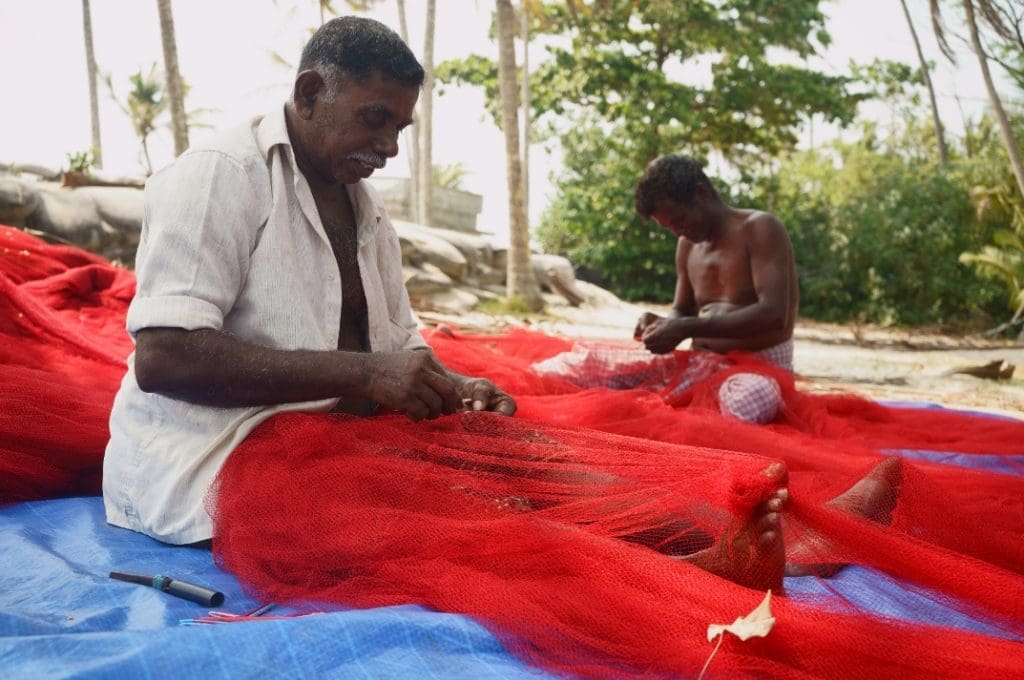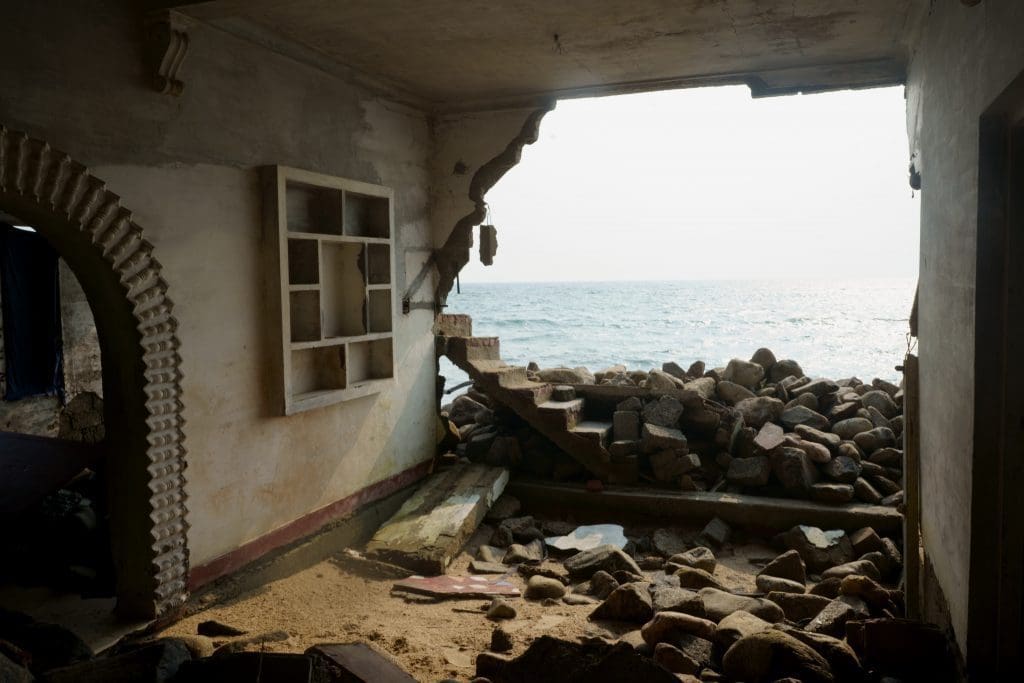
On the 600th day of the indefinite hunger strike, the members of the Chellanam Janakeeya Vedi, in Kochi observed a symbolic milk boiling ceremony, a tradition commonly followed in house warming functions in Kerala, by burning the copies of the Kerala government’s order for the Punargeham project. Punargeham project is a rehabilitation and housing project for fisher families living near areas vulnerable to sea erosion and flood.
Chellanam Janakeeya Vedi is a people’s forum formed in the Kerala coastal village of Chellanam demanding the speedy intervention in the yearly flooding and damage due to coastal ingression.
“On 19th June morning, 9 am, many people assembled near the beaches. We boiled the milk using the fire by burning the copies of the Punargeham order. We shared the milk among all residents. The ashes were later immersed in the sea,” Chellanam Janakiya Vedi chairperson Mariyamma George Kurishinkal told Maktoob.
“In Maruvakkad, Malakhappadi, and some other places, people made paper boats out of the copies of the government order and immersed it in the sea,” she added.
People in Chellanam have been observing indefinite hunger strike demanding a permanent solution to the sea erosion since 28 October 2019. The people’s collective, Chellanam Janakiya Vedi started the indefinite relay hunger strike at a tent in the Companyppady locality near Chellanam. Their main demands were to ensure coastal safety instead of rehabilitation and eviction, ensure a permanent solution for sea erosion on a wartime basis and stop the disregard in the protection of lives and property of coastal people.
As the hunger strike gathered public support, Janakiya Vedi expanded the strike by erecting another tent camp at Bazar area in Chellanam. As the COVID-19 infections intensified, the strike was shifted to homes. Every day a person was assigned to do the hunger strike and their photo was later uploaded on social media.


Chellanam village, 20 kilometres off to the Cochin city, is a densely populated fishing village. The 17.5 km long coast is home to at least 10,000 people, the majority of them belong to the Latin Catholic community. The narrow-strip of Chellanam shares borders to the Arabian Sea to the west and backwaters to the east. The area was marked as highly susceptible to coastal erosion by the Kerala government in 1986.
“Instead of taking enough steps to solve the sea erosion, the government was coming up with plans to rehabilitate people living near the seashore, convenor of the Chellanam Sumyuktha Samara Samiti—roughly translated to Chellanam Strike Coordination Committee told Maktoob.
Under the rehabilitation program ‘Punargeham’ , the government had announced 10 lakh compensation for every family who is willing to vacate their home. Of which, 6 lakh will be allotted to purchase the land and four lakh for the construction of the home. The land documents only will be handed over to the house owner after 12 years. The government also had plans to construct flats in various parts of the state for the fishermen, similar to the Lakshamveed Scheme or One Lakh Housing Scheme.
“At least 85 percent of the people living here are fishing labourers. They are emotionally and economically dependent on the sea. Survival away from the sea is difficult for the locals. Our main demand is a sea wall with a breakwater barrier,” Mariamma who is 74 now, said.
According to VT Sebestian, the Punargeham order is an unconstitutional order. “The order contains a clause that the people who are unwilling to accept the rehabilitation offer will not to be eligible for the compensation fee if affected by natural disasters. This is for eviction. A government was supposed to protect our wealth and life,” VT Sebastian said.
“The flats of mere 450 square feet are too small in size for a coastal family which typically has at least seven-nine members. Moreover, the traditional houses have spaces around the house to dry the fishing nets and equipment. The government designs lack these arrangements.On a larger level, this rehabilitation programme would lead to the ghettoisation of fishing communities to congested spaces, similar to the fate of Dalits and Adivasis in the state who survive in ghettoised ‘colonies’”
People of Chellanam have been facing the wrath of the sea since Okhi cyclone. In November 2017, the Cyclone Okhi, which originated in the Arabian Sea, had created havoc in the Chellanam shore. The sea left a trail of destruction in the village. The giant waves destroyed many houses, blocked toilets, and drainage systems. The waves had deposited huge piles of sand and garbage and it took days to clean up the house.


In the recent flood that happened in May due to the Tauktae cyclone, more than 60 houses in the village have been destroyed with another 200 houses seriously damaged. “Many residents lost their houses. Many shifted to relatives’ homes and rented homes. They are afraid to return fearing another flood,” Mariamma said.
In another flood and sea erosion on August 2020, during the first wave of the pandemic, more than 400 houses in Chellanam had been flooded by seawater. Several houses were filled with waist-high mud. Many people lost electronic devices, groceries, household items and important documents. Vehicles and fibre boats got damaged. “We suffered a huge loss. Many people still haven’t recovered from that,” Mariamma said.


The Chellanam Janakiya Vedi had tried many ways to grab the attention of the general public and the administration. On world environment day, the protesters held a ‘Jalasamadhi’ on the Chellanam seashore. Protesting against the distorted development plans, 58-year-old VT Sebastian conducted the hunger strike on headstand posture on the 281st day of the indefinite hunger strike. The patron of the action committee did the headstand posture for 15 minutes continuously and continued it after a short break of 10 minutes from 10 am to 4pm. On the day of Onam last year, the residents of Chellanam did an innovative protest by forming a human carpet instead of the traditional flower carpet, ‘Pookkalam’. On August 2021, the Janakiya Vedi organised another protest to drain off the sea symbolically by fetching water from the sea using a pot. The collective had also organised a people’s convention at Ernakulam’s Thoppumpady locality and decided to boycott the last Assembly polls in the state.
“The successive governments ignored coastal people. The current left government aims to evict us in the coastal areas en masse. This is our land. We should have the primary rights over the sea and the coast,” says a Chellanam resident Philomina Ignatius aged 65.
“It’s an irony that a government which passed a resolution against the land reforms in Lakshadweep is doing the same violations in Kerala. They are grabbing our land in the name of development, Sebastian said.
Despite the 600 days long protest started in 29, October 2019, neither the demand to reconstruct the Kochi-Chellanam coast nor the installation of groynes were implemented by the ruling government.



